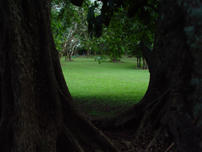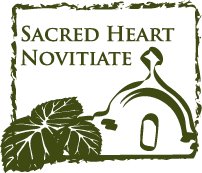A Tribute To The Trees
 So much of the peace and quiet that permeate this House of Spirit come from the serene presence of the trees, which have become one of the earliest inhabitants since the foundation of the place.
So much of the peace and quiet that permeate this House of Spirit come from the serene presence of the trees, which have become one of the earliest inhabitants since the foundation of the place.
These spectacular avenues of towering trees have stood witness for ages to the many weary souls, weary spirits of people who have come to seek refuge away from the madding crowd in the big cities.
Every time I pass through the long entrance of the Doyles’ Walk while looking at the canopy of leaves and branches cast against the blue sky, I hear their tranquil sounds greeting me, as if in a quiet appeal of assuring me that I will find a home in this scenic place, a sweet dwelling during the night like a traveler arriving from a tumultuous journey, a home for my restive soul and for my tired, beat body. From hindsight, these amazing creatures embody the many anthropomorphic qualities and virtues that often only in my dream of dreams will I completely be able to emulate.
Whenever I take a leisurely walk to the outlying grounds of Sacred Heart Novitiate, especially into the forested areas, I always marvel at the great variety of species of trees that have grown there unperturbed. I am fascinated by the diverse characteristics that each species has in terms of shape, height, texture, color, fragrance, and use.
Each tree is unique with its own distinctive features. The Mahogany tree which is found in almost every spot is, of its kind, the most numerous in the vicinity. This tall, heavy-looking, dark tree is valued for its hard-reddish brown wood as timber and as good furniture work. Another of this type is the Teak tree (Tekla) that surrounds the pool area. This deciduous tree can live up to 200 years reaching as high as 150 feet. However, this tree is an easy prey to loggers because of its durable wood that can be used for constructing ships, buildings, bridges, and many others.
A striking contrast to these strong, durable woods is the lowly horseradish or Malunggay tree—a soft, succulent tree found near the kitchen area. Literally, every speck of this tree is edible either as food or as medicine—the leaves, shoots, flowers, pods, roots and bark. Among all the trees I have seen around, this is the most endangered precisely because the moment it sprouts its new leaves the kitchen staff takes it relentlessly and serves it to novices and retreatants to eat.
Known as the “king of fruits” is the Mango tree. This is the novices’ favorite not only as a shade tree but mostly for its wonderfully delicious fruit that is perfect for a lavish dessert. To complete the day, there is the Kapok tree used to stuff the pillows that we snuggle on bed while sleeping at night.
Then upon waking up in the morning, I am greeted by the fresh, fragrant scent and brilliant floral displays of the Narra tree, the Crepe of Myrtle (Banaba) and the cascading Golden Shower (Kanapistola) located right at the façade of the main building.
So much of the peace and quiet that permeate this House of Spirit come from the serene presence of the trees, which have become one of the earliest inhabitants since the foundation of the place.
These spectacular avenues of towering trees have stood witness for ages to the many weary souls, weary spirits of people who have come to seek refuge away from the madding crowd in the big cities.
Every time I pass through the long entrance of the Doyles’ Walk while looking at the canopy of leaves and branches cast against the blue sky, I hear their tranquil sounds greeting me, as if in a quiet appeal of assuring me that I will find a home in this scenic place, a sweet dwelling during the night like a traveler arriving from a tumultuous journey, a home for my restive soul and for my tired, beat body. From hindsight, these amazing creatures embody the many anthropomorphic qualities and virtues that often only in my dream of dreams will I completely be able to emulate.
Whenever I take a leisurely walk to the outlying grounds of Sacred Heart Novitiate, especially into the forested areas, I always marvel at the great variety of species of trees that have grown there unperturbed. I am fascinated by the diverse characteristics that each species has in terms of shape, height, texture, color, fragrance, and use.
Each tree is unique with its own distinctive features. The Mahogany tree which is found in almost every spot is, of its kind, the most numerous in the vicinity. This tall, heavy-looking, dark tree is valued for its hard-reddish brown wood as timber and as good furniture work. Another of this type is the Teak tree (Tekla) that surrounds the pool area. This deciduous tree can live up to 200 years reaching as high as 150 feet. However, this tree is an easy prey to loggers because of its durable wood that can be used for constructing ships, buildings, bridges, and many others.
A striking contrast to these strong, durable woods is the lowly horseradish or Malunggay tree—a soft, succulent tree found near the kitchen area. Literally, every speck of this tree is edible either as food or as medicine—the leaves, shoots, flowers, pods, roots and bark. Among all the trees I have seen around, this is the most endangered precisely because the moment it sprouts its new leaves the kitchen staff takes it relentlessly and serves it to novices and retreatants to eat.
Known as the “king of fruits” is the Mango tree. This is the novices’ favorite not only as a shade tree but mostly for its wonderfully delicious fruit that is perfect for a lavish dessert. To complete the day, there is the Kapok tree used to stuff the pillows that we snuggle on bed while sleeping at night.
Then upon waking up in the morning, I am greeted by the fresh, fragrant scent and brilliant floral displays of the Narra tree, the Crepe of Myrtle (Banaba) and the cascading Golden Shower (Kanapistola) located right at the façade of the main building.
 I move farther into the grounds to pray and I feel mesmerized under this giant Banyan tree. I am dwarfed by the mystery and sacredness behind this huge, ancient tree. It has that distinctive habit of eternally looking up into the sky while letting its roots hang down like strings and tassels to reach for the ground.
I move farther into the grounds to pray and I feel mesmerized under this giant Banyan tree. I am dwarfed by the mystery and sacredness behind this huge, ancient tree. It has that distinctive habit of eternally looking up into the sky while letting its roots hang down like strings and tassels to reach for the ground.
I can go on and on and share more about my discoveries but I think these are quite enough to lead me to the focal point of my reflection. From a backdrop of these diverse characteristics that I have seen, what stands out to my attention is the one quality that is shared by them all. This, also, is their secret why they remain lush and enticing to my senses, a secret to why they exude a quiet, tranquil presence. The one secret quality of these trees is their utter largesse and gratuity.
These trees condescend and bend to provide for their masters’ needs. What is very striking to me is that they grow much healthier only when they give, when they bloom to give color to the surrounding, when they bear fruit which in turn will be passed on to the birds for sowing in far-off barren field. The more they give out oxygen, the more they become lush and green. With the many needs I have, I realize that I am just a breath away from these marvelous creatures.
But there is still one type of tree I know and which I cannot forego to describe for now. This tree has stood for more than 2000 years of its existence and it continues to live. It still bears the nail marks that have gotten through its trunk and branches. Except for its age, there is really nothing extraordinary about this tree; in fact only criminals are hung to die on this tree. Criminal’s blood is splattered all over its rough surface making it so grim and ugly to look at.
This tree has only torn branches, old and shabby, and worn to shreds. But, Oh God, it is this tree that bore the Fruit that saved the whole world, this is the great tree that restored life to me, this tree is the reason for everything that I am now and will be in the future. I will forever kiss the Tree of the Cross with reverent lips, and I will forever embrace it with my own outstretched and empty hands, and thrust it closer to my yearning heart.
 The above reflection yielded from my prayers during my 8-day retreat that formally closed my two years of noviceship in Sacred Heart Novitiate. This summarizes also my own experience of the Cross, which has shown and taught me what it means to be generous. For the life that I am now to embrace is a lifetime of giving, and of ever giving some more until there is already nothing left to give. (May 2003)
The above reflection yielded from my prayers during my 8-day retreat that formally closed my two years of noviceship in Sacred Heart Novitiate. This summarizes also my own experience of the Cross, which has shown and taught me what it means to be generous. For the life that I am now to embrace is a lifetime of giving, and of ever giving some more until there is already nothing left to give. (May 2003)



0 Comments:
Post a Comment
<< Home